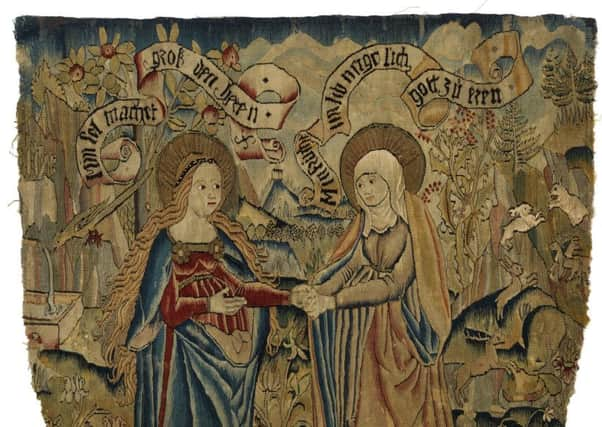City council to pay compensation for looted Nazi spoils


The claim concerns a 16th century Swiss tapestry fragment entitled ‘The Visitation’ which is part of the Burrell Collection.
The Spoliation Advisory Panel is a group of experts, established by the Secretary of State, and its role is to consider claims from anyone, or their heirs, who lost possession of a cultural object during the Nazi era and is now in a UK national collection or another UK museum or gallery.
Advertisement
Hide AdAdvertisement
Hide AdThe tapestry, which measures 81cm x 78cm, depicts the pregnant Virgin Mary and Saint Elizabeth, the future mother of Saint John the Baptist. It is a fragment, cut from a larger tapestry and fashioned into the shape of an ecclesiastical cope hood.
The heirs of Emma Budge lodged the claim. Following her death on February 14, 1937, her family was forced to sell her art collection. Five furniture vans moved the collection to Berlin where two forced auctions took place later in the year. None of the proceeds of the sales went to the heirs of Mrs Budge.
The panel’s report noted: “The tapestry sold, as noted, for 2,500 Reichsmarks. The buyer is recorded to be “Rosenbaum”, who is listed as a buyer of a number of items in the sale. At some stage in 1937 it came, by means of an unidentified transaction, into the possession of John Hunt, from whom Sir William Burrell bought it on August 8, 1938. The Panel has not been told the place of this transaction, the location of the tapestry at the time of this transaction, or the effect of this transaction under the relevant governing law. The panel noted that John Hunt has been the subject of allegations concerning the acquisition of Holocaust-related cultural objects. The panel is not however persuaded that those allegations, even if capable of substantiation, cast any material reflection on the conduct of the city.”
The panel has published its report, which includes the following recommendations which have now been adopted by the Council: That an ex-gratia payment reflecting the current market value should be made to the claimants in respect of the tapestry fragment; the amount of the payment should be agreed between Glasgow Life/the Council and the claimant or fixed by a third party valuer if the parties are unable to agree; in exchange for the payment referred to above, that the claimants release and relinquish any surviving title or claim to the Object; and that when the object is exhibited it is accompanied by a credit acknowledging the circumstances in which the estate was deprived of the object and the terms on which the claim was resolved.
Advertisement
Hide AdAdvertisement
Hide AdGlasgow City Council has been at the forefront of UK museums’ attempts to reconcile objects with ‘uncertain provenance’ and which may have entered collections as a result of Nazi atrocities. The tapestry fragment was published on the UK Government’s Spoliation website in July 2004. Glasgow Museums contacted the Hunt Archive in 2006 but failed to glean any documentation casting further light on the history of the tapestry in the months between the 1937 auction and Sir William’s acquisition on August 8, 1938 of the tapestry from John Hunt at a cost of £315. The 1938 entries in the Burrell Purchase Book remain the only known documentary evidence for the Hunt transaction. Further research by the Hunt Museum in 2009 did however reveal Rosenbaum as the original purchaser in 1937.
The Board of Glasgow Life, which manages the city’s museums and collections on behalf of the Council, approved the validity of the request and upheld the recommendations of the Spoliation Advisory Panel. Discussions will now be held with representatives of the Budge estate over the ex-gratia payment.
Two valuations have been acquired for the tapestry fragment from Sotheby’s and Christies and will form the basis of discussions over the value of the work, however the council declined to say what these are.
Councillor Archie Graham, the Depute Leader of Glasgow City Council and Chair of Glasgow Life, said: “Glasgow has led the way in attempting to identify objects that may have been acquired as a result of Nazi atrocities and has been posting details of objects where provenance may not be certain on the UK Government’s website since 1998. In cases where a claim is proven, the city has always been resolute that it has a moral duty to put right the mistakes of the past, no matter how long the passage of time.”
The full copy of the Spoliation Advisory Panel’s report can be found here: https://www.gov.uk/government/uploads/system/uploads/attachment_data/file/378754/44198_HC_776_accessible.pdf